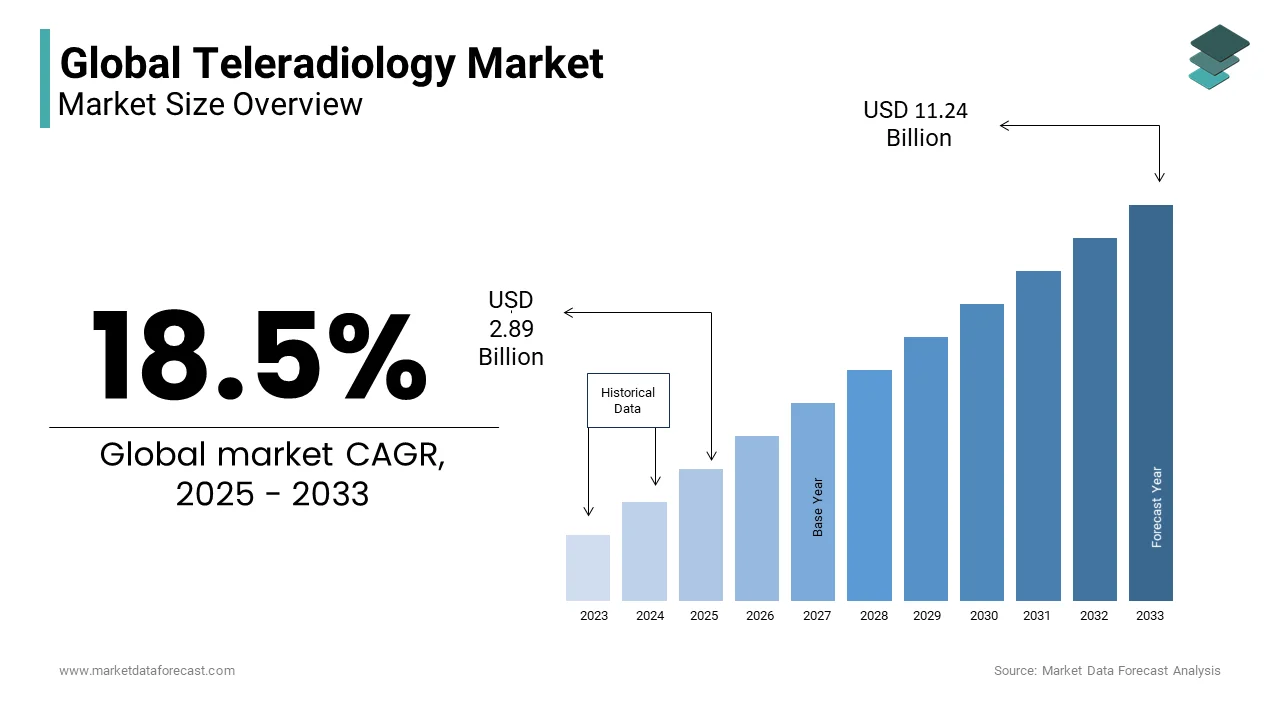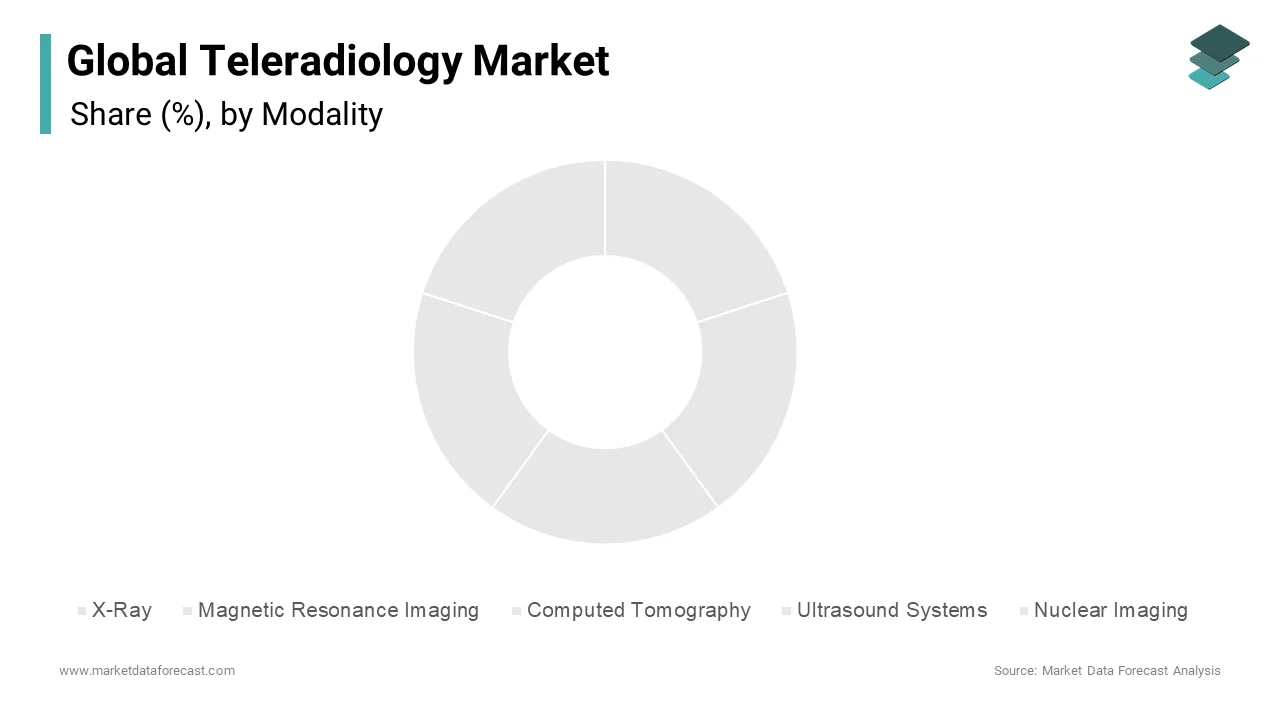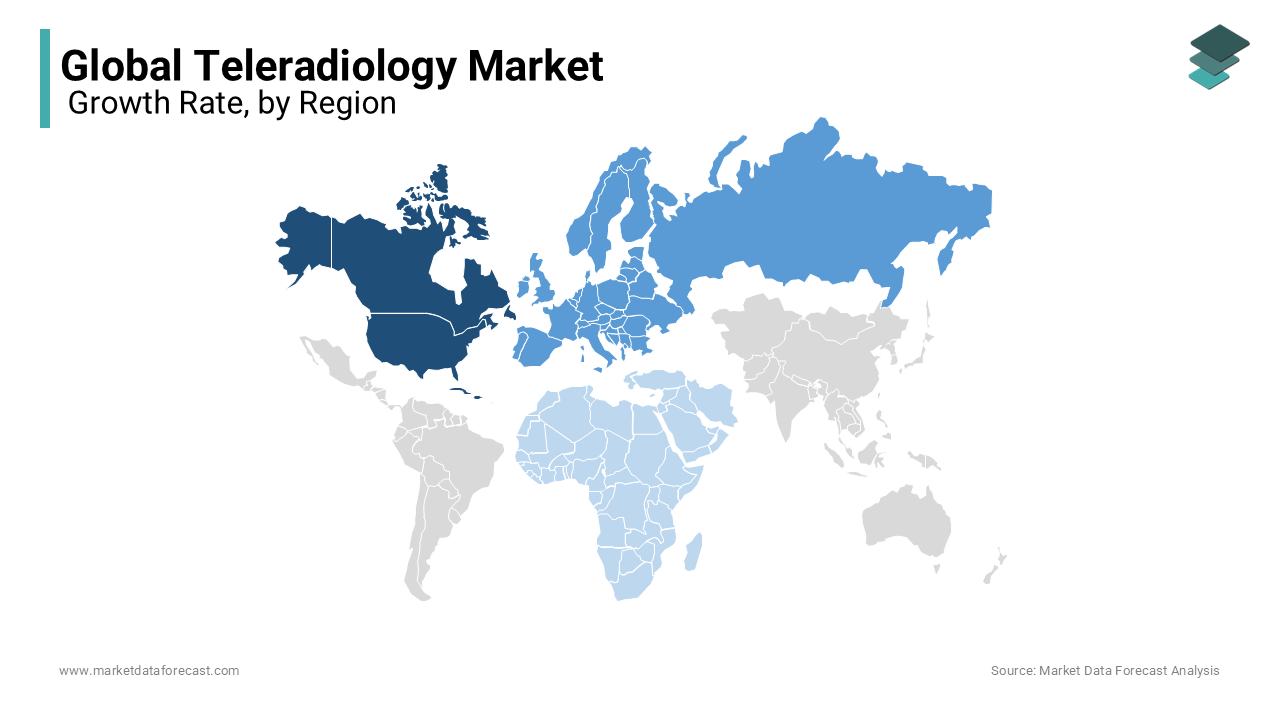Global Teleradiology Market Size, Share, Trends and Growth Forecast Report – Segmented By Modality (X-Ray, Magnetic Resonance Imaging, Computed Tomography, Ultrasound Systems and Nuclear Imaging), Application (Web-Based and Cloud-based), Technology Solutions and Region (North America, Europe, Asia Pacific, Latin America, and Middle East & Africa) - Industry Analysis (2025 to 2033)
Global Teleradiology Market Size
In 2024, the global teleradiology market was valued at USD 2.44 billion and it is expected to reach USD 11.24 billion by 2033 from USD 2.89 billion in 2025, growing at a CAGR of 18.5% during the forecast period.

Teleradiology is a subcategory of telemedicine in which radiological images are transmitted from one location to another through telecommunication systems. All non-invasive imaging research, including digitized X-rays, MRI, ultrasound, CT and nuclear medicine studies, may be perceived this way. Digitized images are now routinely transmitted around the world through high-speed telecommunication links. Teleradiology is also an essential component of medical facilities, such as the increasing use of teledentistry; more studies are being conducted to demonstrate its usefulness. For example, recently explored the clinical utility of teleradiology in general dental practice. In the report, about 275 cases were sent for review to the Korean Academy of Oral and Maxillofacial Radiology's case presentation board.
MARKET DRIVERS
The rapid adoption of technology-enabled healthcare platforms is majorly propelling the global teleradiology market growth.
The growing healthcare infrastructure among developing countries, increasing availability of high-speed internet facilities, and growing healthcare expenditure propel the global teleradiology market growth. The global teleradiology market is further driven by technological advancements in the healthcare industry, growing digitalization, which aids in enhancing the Teleradiology process, and low costs in contrast to other modalities. Secondary factors include the shortage of radiologists worldwide, digital technology advancements in external patient diagnoses, and enhanced healthcare awareness. On the other hand, inadequate common standards are the primary barrier to the global teleradiology market.
The growing demand for radiology services across the globe is expected to boost the global teleradiology market.
Teleradiology is used to enhance tuberculosis screening and case management. Thyolo district in southern Malawi is home to approximately 600,000 residents. The World Health Organization (WHO) recommends 228 health practitioners per 100,000 people. 159 X-ray images from 158 patients at Thyolo District Hospital were submitted for teleradiology from September 2010 to September 2011.
Technological advancements in teleradiology are further expected to accelerate market growth.
Teleradiology's usage reflects the evolving worlds of clinical practice, technology, and service delivery. Healthcare delivery is evolving, and teleradiology is a part of that transition, which also involves radiology's globalization. The current challenge is to address the inability to seamlessly incorporate teleradiology systems with other (locally existing) healthcare information systems when data must be transmitted between institutions or an outside provider.
Continuously increasing demand for CT scans due to lower exposure to X-rays and high scanning speed is expected to provide key player opportunities during the forecast period. Expansion of teleradiology in developing countries owing to emerging economies and increasing patient pool is likely to offer lucrative opportunities for the growth of the global teleradiology market. Other factors, such as the emergence of technologically advanced products, increased prevalence of various diseases, and expanding healthcare in developing countries, are anticipated to create lucrative growth opportunities for the key players in the global teleradiology market.
MARKET RESTRAINTS
The major challenge for the key players functioning in the global teleradiology market is radiation exposure.
Side effects associated with the treatment are expected to restrain the growth of the teleradiology market. In addition, the lack of proper distribution networks in developing regions and unfavorable reimbursement policies challenge the key players functioning in the worldwide teleradiology market. The lack of timely diagnostic facilities poses severe challenges for clinicians during emergencies and at night. However, teleradiology services are currently defined by a trade-off between cost and image quality, billing and quality of care issues, payment challenges, and state licensure requirements. In addition, problems with privacy and security, lack of awareness in developing countries, and risk of a cyber-attack on data are further expected to restrict the teleradiology market growth.
REPORT COVERAGE
|
REPORT METRIC |
DETAILS |
|
Market Size Available |
2024 to 2033 |
|
Base Year |
2024 |
|
Forecast Period |
2025 to 2033 |
|
CAGR |
18.5% |
|
Segments Analysed |
By Modality, Technology Solutions, Application, and Region |
|
Various Analyses Covered |
Global, Regional & Country Level Analysis, Segment-Level Analysis; DROC; PESTLE Analysis; Porter’s Five Forces Analysis; Competitive Landscape; Analyst Overview of Investment Opportunities |
|
Regions Analysed |
North America, Europe, Asia Pacific, Latin America, the Middle East, and Africa |
|
Key Market Players |
4ways Healthcare Limited, RamSoft, Inc., Virtual Radiologic (vRAD), Agfa-Gevaert N.V., ONARD, Global Diagnostics, Everlight Radiology, Sectra AB, and Health Watch Tele Diagnostics Pvt. Ltd. |
SEGMENTAL ANALYSIS
By Modality Insights
The CT segment had the major share of the global teleradiology market in 2024 and the domination of the segment is anticipated to continue during the forecast period. CT is most commonly used to diagnose various diseases and is highly effective in producing detailed images of internal body structures. The growing patient population suffering from chronic diseases, the increasing aging population, the rising demand for remote patient monitoring, and the growing demand for rapid and accurate diagnosis are majorly contributing to segmental growth.

The MRI segment captured a substantial share of the worldwide market in 2024 and is projected to grow at a healthy CAGR during the forecast period. Increasing usage of MRI to treat cancer patients and rapid adoption of technological developments are favoring the segment’s growth rate.
The X-ray is one of the most lucrative segments and is expected to witness a notable CAGR during the forecast period. The growth of the X-ray segment is majorly driven by the growing demand for imaging services and the increasing number of initiatives by the governments.
By Technology Solutions Insights
The cloud-based segment held the largest share of the global teleradiology market in 2024 and is likely to witness rapid growth during the forecast period owing to the increasing demand for artificial intelligence and the high adoption rate of cloud-based technologies to store large amounts of collected data. Furthermore, the ability to store, access and share medical images securely and remotely further propel the segment's growth rate. In addition, faster turnaround times for image interpretation and diagnosis and easy scalability and accessibility are boosting the segment's growth. Furthermore, the growing demand for remote patient monitoring and telemedicine services favours segmental growth.
During the forecast period, the web-based segment is anticipated to grow at a moderate CAGR. Factors such as the availability of high-speed internet in many countries, growing adoption of web-based technologies, cost-effectiveness, and growing patient count suffering from chronic diseases are driving the segmental growth.
By Application Insights
The PACS segment held the major share of the global teleradiology market in 2024 and the segment’s domination is likely to continue throughout the forecast period. The growing demand for digital medical imaging and the increasing need to store and access medical access electronically contribute to segmental growth. In addition, the benefits associated with PACS such as improved efficiency, faster turnaround times, enhanced patient care, and reduced healthcare costs are further fuelling the segment's growth rate. Furthermore, PACS further helps healthcare providers improve their workflow, reduce the risk of errors, and improve communication between healthcare professionals, which is resulting in the growing adoption of PACS and boosting the segment’s growth rate.
On the other hand, the RIS segment is also anticipated to grow at a notable CAGR during the forecast period owing to the rising demand for a comprehensive system that can manage the entire radiology workflow, from patient registration to billing. In addition, the adoption of RIS is picking up among healthcare providers due to the associated advantages, such as automating their workflow, reducing manual errors, and improving communication between healthcare professionals.
REGIONAL ANALYSIS
North America held the major share of the worldwide market in 2024 and the domination of the segment is estimated to continue during the forecast period owing to the increasing prevalence of chronic diseases and the presence of high-end multi-specialty healthcare facilities in the North American countries. Furthermore, factors such as the increasing patient count suffering from chronic diseases in the North American region and growing demand for remote patient monitoring, home healthcare and telemedicine propel the North American teleradiology market growth. During the forecast period, the U.S. is predicted to hold the major share of the North American market, followed by Canada. Due to the increasing number of diagnostic imaging centers, the Canadian teleradiology market is expected to witness a healthy CAGR in the coming years.

Europe is expected to capture a substantial share of the worldwide market during the forecast period. The COVID-19 pandemic has severely impacted Europe and the usage of teleradiology has increased significantly during the COVID-19 pandemic. Furthermore, the initiatives taken by the European Union such as the Digital Single Market strategy and the General Data Protection Regulation (GDPR) have favored the teleradiology market growth in Europe recently. In addition, factors such as the favorable regulatory environment for teleradiology in Europe and the rapid adoption of technological advancements are boosting the European teleradiology market growth. The UK, Germany, and France captured the major share of the European market in 2021; the trend is predicted to continue during the forecast period. The UK is predicted to witness a notable CAGR during the forecast period due to the increasing healthcare expenditure by the UK government and the increasing adoption of radiological services.
Asia-Pacific is estimated to showcase a promising CAGR during the forecast period. The growing chronic disease patient population and consistent improvements in the healthcare infrastructure in the APAC countries are propelling the growth rate of the APAC market. In addition, the rising adoption of technological developments and growing disposable income among the APAC population are contributing to regional market growth. Furthermore, the presence of developing countries such as India and China is estimated to fuel regional market growth. Factors such as the increasing demand for innovative and advanced medical platforms, the growing number of government initiatives, and growing efforts by the key market participants to tap the untapped market potential of the developing countries are promoting the growth of the APAC teleradiology market.
Latin America is anticipated to experience a steady CAGR during the forecast period. The growing demand for teleradiology services majorly drives the growth of the Latin American market due to the increasing patient population suffering from chronic diseases and the rising adoption of digital healthcare technologies.
During the forecast period, the MEA is predicted to occupy a moderate share of the worldwide market.
KEY MARKET PLAYERS
Some of the notable companies dominating the global teleradiology market profiled in the report are 4ways Healthcare Limited, RamSoft, Inc., Virtual Radiologic (vRAD), Agfa-Gevaert N.V., ONARD, Global Diagnostics, Everlight Radiology, Sectra AB, and Health Watch Tele Diagnostics Pvt. Ltd.
RECENT HAPPENINGS IN THIS MARKET
- USA rad Company launched a new teleradiology program for screening novel coronavirus disease. The program offers various radiologists for diagnosing coronavirus patients. The company has collaborated with the Medical Diagnosis web and provides a network of radiologists across the globe. The principal objective of these radiologists is to upload images of the patients affected by the coronavirus, which the CT-trained specialists analyze. The CEO of USArad also announced that they are going to deploy AI algorithms to aid physicians.
- Ramsoft Inc. launched three applications at the RSNA meeting in 2018. The apps offer various features to the patients, like reports and image sharing, fixing, or cancellation of imaging appointments through text, email, or voice services. The company also collaborated with an image-sharing platform called HIPAA, which offers electronic image and report-sharing options.
MARKET SEGMENTATION
This research report on the global teleradiology market has been segmented and sub-segmented based on the modality, technology solutions, application, and region.
By Modality
- X-Ray
- Magnetic Resonance Imaging
- Computed Tomography
- Ultrasound Systems
- Nuclear Imaging
By Technology Solutions
- Web-Based
- Cloud-based
By Application
- Picture Archiving and Communication System (PACS)
- Radiology Information System (RIS)
By Region
- North America
- Europe
- Asia Pacific
- Latin America
- The Middle East and Africa
Frequently Asked Questions
How much is the global teleradiology market going to be worth by 2033?
As per our research report, the global teleradiology market size is projected to be USD 11.24 billion by 2033.
Which region is growing the fastest in the global teleradiology market ?
Geographically, the North American teleradiology market accounted for the largest share of the global market in 2024.
At What CAGR, the global teleradiology market is expected to grow from 2024 to 2033?
The global teleradiology market is estimated to grow at a CAGR of 18.5% from 2024 to 2033.
Related Reports
Access the study in MULTIPLE FORMATS
Purchase options starting from $ 2500
Didn’t find what you’re looking for?
TALK TO OUR ANALYST TEAM
Need something within your budget?
NO WORRIES! WE GOT YOU COVERED!
Call us on: +1 888 702 9696 (U.S Toll Free)
Write to us: sales@marketdataforecast.com
